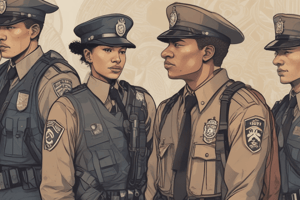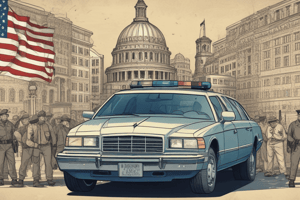Podcast
Questions and Answers
What is the primary focus of this lesson plan?
What is the primary focus of this lesson plan?
- Dealing with suicidal behavior in emergency situations
- Learning about social agencies and support groups
- Developing communication skills for general police work
- Addressing communication obstacles in special situations (correct)
What is recommended for new peace officers dealing with communication obstacles?
What is recommended for new peace officers dealing with communication obstacles?
- Try to resolve every obstacle on your own
- Seek help from social agencies, support groups, and trained individuals (correct)
- Only rely on their training and experience
- Avoid dealing with special situations altogether
What is one of the objectives of this lesson plan?
What is one of the objectives of this lesson plan?
- Locate services available in the community for referral of those with a high suicide risk (correct)
- Learn about the five principles for overcoming communication barriers
- Develop strategies for dealing with the mentally disturbed
- Identify three ways of overcoming communication barriers
Why is it important for peace officers to become acquainted with professionals in their patrol area?
Why is it important for peace officers to become acquainted with professionals in their patrol area?
What is the purpose of meeting professionals in the patrol area?
What is the purpose of meeting professionals in the patrol area?
What is one of the communication obstacles discussed in this lesson plan?
What is one of the communication obstacles discussed in this lesson plan?
What percentage of waking time does the average human being spend on linguistic communication?
What percentage of waking time does the average human being spend on linguistic communication?
What is the recommended approach for new peace officers in dealing with special situations?
What is the recommended approach for new peace officers in dealing with special situations?
What is a major barrier to communication according to the text?
What is a major barrier to communication according to the text?
What is one of the objectives of this lesson plan related to suicide?
What is one of the objectives of this lesson plan related to suicide?
Why might females in law enforcement be seen as a threat in some cultures?
Why might females in law enforcement be seen as a threat in some cultures?
What can impact a person's communication skills and vocabulary?
What can impact a person's communication skills and vocabulary?
What is one way to expand one's vocabulary?
What is one way to expand one's vocabulary?
What can be used as a resource for communicating with persons who do not speak English?
What can be used as a resource for communicating with persons who do not speak English?
Why is it important to learn common words and phrases of an ethnic group?
Why is it important to learn common words and phrases of an ethnic group?
What can impact the perception of a police agency's professionalism?
What can impact the perception of a police agency's professionalism?
What percentage of waking time do law enforcement officers spend on communication?
What percentage of waking time do law enforcement officers spend on communication?
What is one way to build a rapport with a person from a different social background?
What is one way to build a rapport with a person from a different social background?
What can overcome even a bad event or poor agency reputation in a community setting?
What can overcome even a bad event or poor agency reputation in a community setting?
What is essential for law enforcement to remain when responding to calls for service or during citizen contacts?
What is essential for law enforcement to remain when responding to calls for service or during citizen contacts?
Which of the following is NOT one of the categories of barriers to communication?
Which of the following is NOT one of the categories of barriers to communication?
What is essential to practice to overcome communication barriers?
What is essential to practice to overcome communication barriers?
Who should accept responsibility for barriers to communication?
Who should accept responsibility for barriers to communication?
What can result from physical discomfort or inadequate facilities?
What can result from physical discomfort or inadequate facilities?
Why are physical barriers often the easiest to overcome?
Why are physical barriers often the easiest to overcome?
What type of barrier arises from perceived situations?
What type of barrier arises from perceived situations?
What can be affected by spatial situations?
What can be affected by spatial situations?
Why is it essential for law enforcement to recognize and overcome barriers to communication?
Why is it essential for law enforcement to recognize and overcome barriers to communication?
What is a consequence of officers developing a negative attitude towards the community?
What is a consequence of officers developing a negative attitude towards the community?
What is a common obstacle to effective communication in law enforcement?
What is a common obstacle to effective communication in law enforcement?
What percentage of social messages are estimated to be transmitted nonverbally?
What percentage of social messages are estimated to be transmitted nonverbally?
What is a key step in overcoming communication barriers?
What is a key step in overcoming communication barriers?
What is the result of not taking time to analyze problems in communication?
What is the result of not taking time to analyze problems in communication?
What is a way to decrease miscommunication?
What is a way to decrease miscommunication?
What is a potential consequence of not overcoming communication barriers?
What is a potential consequence of not overcoming communication barriers?
What is a key aspect of overcoming intercultural and interracial barriers?
What is a key aspect of overcoming intercultural and interracial barriers?
What is a common mistake made by law enforcement officers during interactions?
What is a common mistake made by law enforcement officers during interactions?
What is the importance of understanding nonverbal communication in law enforcement?
What is the importance of understanding nonverbal communication in law enforcement?
What is the primary role of words in communication, according to the author?
What is the primary role of words in communication, according to the author?
What is the main problem with using jargon in communication, according to the text?
What is the main problem with using jargon in communication, according to the text?
What is the most important aspect of effective listening, according to the author?
What is the most important aspect of effective listening, according to the author?
Why do police officers often fail to listen effectively, according to the text?
Why do police officers often fail to listen effectively, according to the text?
What percentage of people learn through their eyes or ears, according to the text?
What percentage of people learn through their eyes or ears, according to the text?
What is the most significant barrier to communication in critical situations, according to the text?
What is the most significant barrier to communication in critical situations, according to the text?
What is the leading cause of death in the United States, according to the text?
What is the leading cause of death in the United States, according to the text?
What is the primary goal of communication in law enforcement, according to the text?
What is the primary goal of communication in law enforcement, according to the text?
What is the main benefit of improving listening skills, according to the text?
What is the main benefit of improving listening skills, according to the text?
What is the primary reason why police officers need to be aware of their communication style, according to the text?
What is the primary reason why police officers need to be aware of their communication style, according to the text?
What is the fourth 'person' that may have a significant impact on our communication?
What is the fourth 'person' that may have a significant impact on our communication?
What is a major source of misunderstanding and failure to communicate in groups?
What is a major source of misunderstanding and failure to communicate in groups?
In what situations is a rank relationship necessary for effective communication?
In what situations is a rank relationship necessary for effective communication?
What is the primary reason why police officers reacted negatively to being referred to as 'pigs'?
What is the primary reason why police officers reacted negatively to being referred to as 'pigs'?
What is the term for the tendency to reject new or different ideas?
What is the term for the tendency to reject new or different ideas?
What is the primary reason why people tend to react negatively towards those they perceive in a negative way?
What is the primary reason why people tend to react negatively towards those they perceive in a negative way?
What is the term for the barriers that arise from the peculiar problems and situations faced by law enforcement?
What is the term for the barriers that arise from the peculiar problems and situations faced by law enforcement?
What is the common perception of firemen as compared to policemen?
What is the common perception of firemen as compared to policemen?
What is the primary reason why attitudinal barriers arise?
What is the primary reason why attitudinal barriers arise?
What is the term for the phenomenon where individuals tend to react negatively towards new or different ideas?
What is the term for the phenomenon where individuals tend to react negatively towards new or different ideas?
What is the approximate average number of reported suicides annually?
What is the approximate average number of reported suicides annually?
What is the most common requested language by U.S. clients, according to the text?
What is the most common requested language by U.S. clients, according to the text?
What percentage of people who succeed at suicide have attempted it previously?
What percentage of people who succeed at suicide have attempted it previously?
What is the most common method of suicide?
What is the most common method of suicide?
What is the primary role of law enforcement in involuntary detention of a person suspected of suffering from mental illness?
What is the primary role of law enforcement in involuntary detention of a person suspected of suffering from mental illness?
What is a common sign of potential suicide?
What is a common sign of potential suicide?
What is the criterion for determining whether a person is mentally disturbed and in need of detention?
What is the criterion for determining whether a person is mentally disturbed and in need of detention?
What is the ranking of suicide as a cause of death among adolescents in the 15-19-year-old range?
What is the ranking of suicide as a cause of death among adolescents in the 15-19-year-old range?
What is the legal provision that permits police officers to take psychologically disturbed people into custody for evaluation and treatment?
What is the legal provision that permits police officers to take psychologically disturbed people into custody for evaluation and treatment?
What is the primary reason for erroneous reporting of suicide as accidental death?
What is the primary reason for erroneous reporting of suicide as accidental death?
What is the definition of a mental disorder, according to the text?
What is the definition of a mental disorder, according to the text?
What should be done when a person appears suicidal or is threatening suicide?
What should be done when a person appears suicidal or is threatening suicide?
What is the most common method of suicide, according to the text?
What is the most common method of suicide, according to the text?
What is a common feeling that accompanies thoughts of suicide?
What is a common feeling that accompanies thoughts of suicide?
What percentage of people who succeed at suicide have attempted it previously, according to the text?
What percentage of people who succeed at suicide have attempted it previously, according to the text?
What should police officers do to help individuals in need of suicide prevention?
What should police officers do to help individuals in need of suicide prevention?
What is the recommended approach when responding to an attempted suicide in progress?
What is the recommended approach when responding to an attempted suicide in progress?
What is the consequence of not taking a person into custody when they are suspected of being mentally disturbed, according to the text?
What is the consequence of not taking a person into custody when they are suspected of being mentally disturbed, according to the text?
What is a resource that can be used to communicate with persons who do not speak English?
What is a resource that can be used to communicate with persons who do not speak English?
What is the significance of the 1994 double murder case study in the context of detention of the mentally disturbed?
What is the significance of the 1994 double murder case study in the context of detention of the mentally disturbed?
Flashcards are hidden until you start studying
Study Notes
Communication Obstacles in Law Enforcement
- Communication barriers can interfere with good communication opportunities in law enforcement.
- Five principles to overcome communication barriers:
- Recognize and admit that barriers exist.
- Understand what the barriers are and factors that impact them.
- Accept at least part of the responsibility for the barriers.
- Develop a desire and willingness to overcome them.
- Take positive action to overcome them.
Barriers to Communication
- Physical barriers:
- Physical illness
- Mechanical failures
- Language differences
- Poor facilities or physical discomfort
- Perceptual barriers:
- Perceived situations that affect communication
- Spatial situation (e.g., close proximity producing discomfort)
- Failure to recognize someone's role or feelings
- Psychological/attitudinal barriers:
- Status gaps
- Semantic differences
- Attitudinal barriers (e.g., failure to accept opposing views)
- Job-related barriers:
- Intradepartmental or interdepartmental frictions
- Failure to accept that a "police culture" exists
- Intercultural and interracial barriers:
- Failure to establish better intercultural and interracial relationships
- Prejudices
Overcoming Communication Barriers
- Learn to recognize more about the human nature of the problem of barriers.
- Take time to analyze the problem and find solutions.
- Nonverbal communication:
- Estimated 65% of social messages are transmitted nonverbally.
- Nonverbal cues can be powerful tools in communication.
- Proper use of language:
- Choose the right words for the context.
- Avoid using jargon or technical words that may be misunderstood.
- Effective listening:
- Listen more and talk less.
- Be willing to hear the other person's perspective.
- Avoid interrupting or dominating the conversation.
Dealing with Special Situations
-
Communicating with the mentally disturbed:
- Identify common signs of a potential suicide victim.
- Identify feelings that accompany thoughts of suicide.
- Locate services available in the community for referral.
-
Dealing with the hearing impaired:
- Identify basic techniques to communicate with a deaf and/or mute person.
-
Handling potentially suicidal behavior:
- Identify the role of peace officers in involuntary detention.
- Identify the role of the patrol officer as first responder.
- Demonstrate basic techniques to calm/stabilize a situation involving a suicide attempt.### Importance of Listening and Attention in Communication
-
90-100% of all that a person learns in a lifetime is learned through the eyes or ears
-
Good listening and attention skills are crucial for effective communication, especially in law enforcement
-
Officers must hear well, make immediate judgments, retain what is important, and respond meaningfully, fairly, and wisely
Challenges in Communication
- Communication can be difficult even on a good day
- Trauma, stress, critical incidents, and mental or physical illnesses can make communication even more challenging
Suicide Prevention and Intervention
- Suicide is the leading cause of death in the United States, with an average of 20,000 reported suicides annually
- At least 50% of all people who succeed at suicide have attempted it previously, and 75% give clear warning that they intend to kill themselves
- Common methods of suicide include gun, hanging, ingested poison, and carbon monoxide
- Common signs of potential suicide include:
- Giving away prized possessions
- Making remarks about one's own death
- Changing insurance policy or arranging for security of dependent others
- A sharp and sudden rise in mood after a long period of depression
- Saving up pills or obtaining a weapon
- Threats of suicide should never be taken lightly, and a person who appears suicidal or is threatening suicide needs psychiatric help
- Effective intervention in personal crises requires skill, experience, training, and a genuine concern for the welfare of others
Resources for Suicide Prevention
- Officers should be aware of resources that can help them assist individuals in need, including:
- Emergency communication centers
- Fire control centers
- Poison Control Centers
- Hospitals and medical centers
- Social agencies
- Mental health centers
- Hot-line services
- Officers should also be aware of resources that can help them communicate with individuals who do not speak English, including:
- Locally, AT&T Language Line (1-800-643-2255)
- Community volunteers who speak non-English languages
- Language training programs
Involuntary Detention of the Mentally Disturbed
- The primary role of law enforcement is answering calls, and in some cases, the focus of these calls may involve individuals suffering from mental illness or disorder
- Officers must make decisions based on the following criteria:
- Persons exhibit symptoms of a mental disorder, mental illness, or appear to be under the influence of alcohol and/or other drugs
- The person's behavior indicates a likelihood of serious physical harm
- Officers may take individuals into custody for the purposes of evaluation and treatment, and must obtain affidavits and make application for 96-hour detention, evaluation, and treatment
Case Study: The 1994 Double Murder in Glendale
- A mentally retarded adult son killed both his parents in the family home after telling family members for two weeks that he was going to do it
- The serious legal ramifications of detention of the mentally disturbed are obvious, and officers should be familiar with the legal and psychological factors on which to decide whether or not to take a mentally disturbed person into custody
Studying That Suits You
Use AI to generate personalized quizzes and flashcards to suit your learning preferences.





